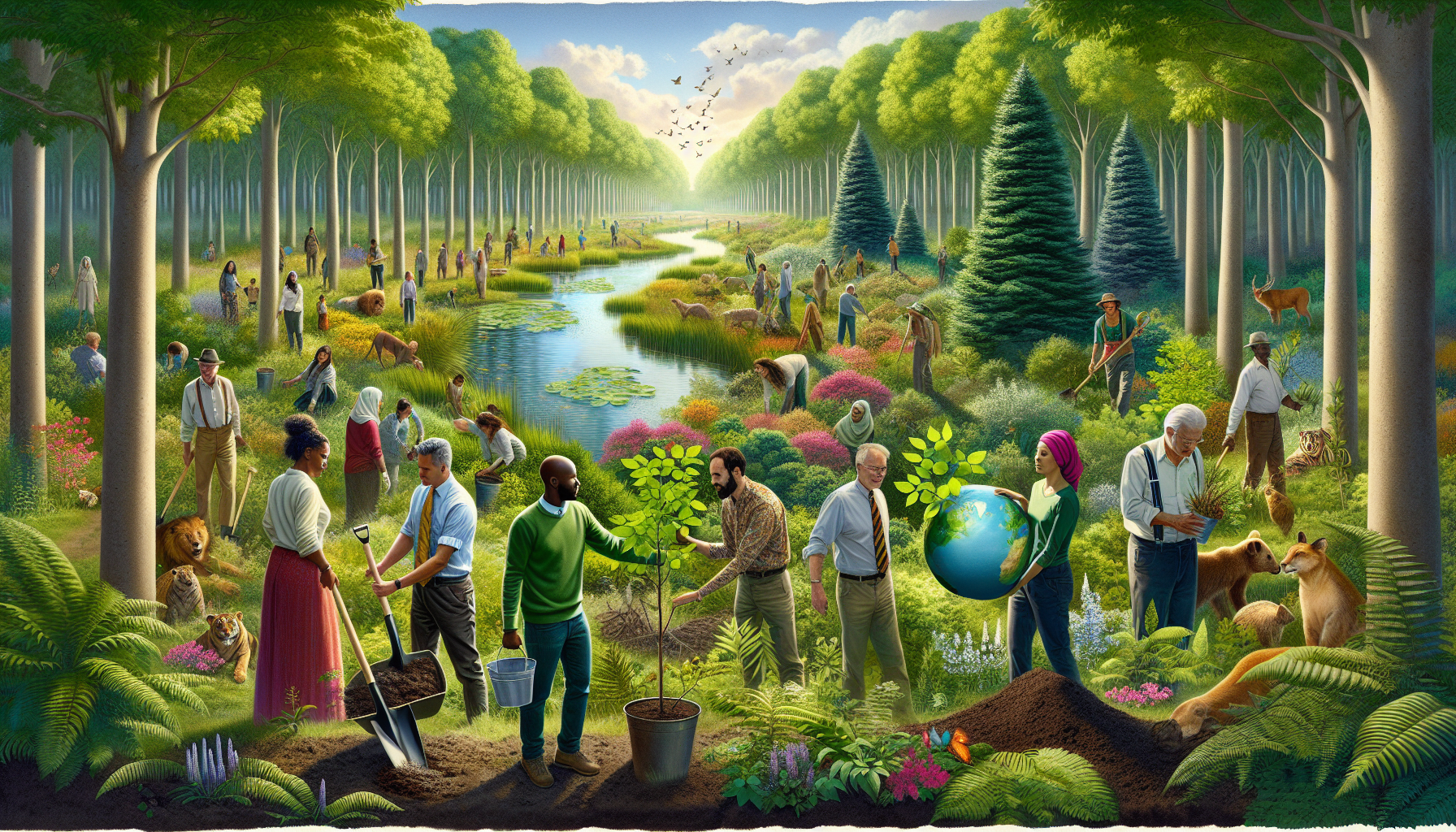Native Woodlands - so many benefits
Native Woodland Creation: A Green Solution with Multiple Benefits
In our journey toward a greener future, native woodland creation stands as a beacon of hope for environmentally-sensitive areas. By embracing this initiative, we not only foster biodiversity but also contribute significantly to carbon sequestration, addressing the urgent issue of climate change. This approach becomes even more vital as organizations like Cloudforests.ie lead by example, creating native Irish woodlands along Ireland's Wild Atlantic Way, including two remarkable projects on the Dingle Peninsula and at Ennistymon. Their unique membership package invites companies to join their environmental mission, embodying the spirit of partnership and community action.
Woodland creation, especially in areas like the Dingle Peninsula and Ennistymon, showcases a model for flood mitigation and water management while offering profound socio-economic benefits. As we delve into this article, we'll explore the multifaceted advantages of establishing woodlands, emphasizing how such acts of environmental stewardship can reinforce our collective efforts against climate change and beyond. Our commitment to this cause, along with partnerships like those forged by Cloudforests.ie, heralds a promising path toward sustainability and community resilience.
Biodiversity Enhancement through Woodland Creation
In our efforts to enhance biodiversity through native woodland creation, organisations like Moor Trees have observed significant benefits, underscoring the importance of such initiatives [1].
Habitat Enrichment:
A single oak tree can become a sanctuary for over 10,000 insects, illustrating the critical role woodlands play in supporting insect populations [1].
Fungi, with their symbiotic relationships with trees, enrich the biodiversity of Dartmoor and South Devon's native woodlands [1].
Native species thrive in these woodlands, benefiting from the UK' and Irelands unique climate to support a higher level of biodiversity, including rare temperate rainforest habitats [3].
Structural Diversity and Soil Health:
The diverse forest structure, including standing and fallen deadwood, promotes a variety of species, from rare birds to invertebrates and fungi [4].
Supporting Pollinators and Wildlife:
Approximately three-quarters of all crops depend on insect pollination, making woodlands essential for pollinators like bumblebees and butterflies by providing safe refuges and reliable food sources [2].
Encouraging natural colonisation and regeneration supports complex biodiversity within soils, eliminating biosecurity risks and fostering a variety of tree and plant species [2].
These efforts align with the mission of Cloudforests.ie, which has established native woodlands in Ireland, offering a unique opportunity for companies to join their environmental mission and contribute to biodiversity enhancement [source].
Carbon Sequestration and Climate Change Mitigation
In the quest to mitigate climate change, native woodland creation emerges as a pivotal strategy, significantly enhancing carbon sequestration and bolstering soil health. This process not only safeguards soils but also maintains essential climate regulation mechanisms [2]. Through the strategic planting of native tree species, organisations like Cloudforests.ie are leading the charge in transforming environmentally-sensitive areas into vibrant ecosystems. Their efforts in establishing native woodlands along Ireland's Wild Atlantic Way, including projects on the Dingle Peninsula and at Ennistymon, exemplify the profound impact of reforestation on carbon capture. This initiative invites companies to partake in their environmental mission, fostering a collective approach to combating climate change.
Carbon Storage Dynamics: Forests, through the process of photosynthesis, absorb CO2, effectively contributing to carbon capture and storage. This cycle varies with the forest's age, with young forests capturing carbon rapidly due to their dense tree populations, while mature forests excel in long-term carbon storage [9]. The role of soil in this process is equally critical, storing carbon in various forms such as plant roots and leaf litter, with the amount stored influenced by factors like soil type and vegetation [9].
Forest Management for Enhanced Carbon Sequestration:
Preventing Soil Damage: Reducing soil disturbance during harvesting and extending rotation periods are key in preserving soil carbon sinks [9].
Invasive Species Control: Managing invasive plants is vital for maintaining a forest's carbon sequestration capacity [9].
Utilization of Wood Products: Harvesting slow-growing trees for durable wood products contributes further to carbon sequestration, as these products store carbon and can replace more energy-intensive materials [9][10].
By leveraging thoughtful forest management practices and increasing forest cover, we can significantly bolster our efforts in climate change mitigation. The collaborative model adopted by Cloudforests.ie, encouraging companies to engage in reforestation projects, exemplifies how community and corporate participation can amplify the impact of native woodland creation on carbon sequestration and overall environmental health.
Flood Mitigation and Water Management
Understanding the role of native woodland in flood mitigation and water management reveals a multi-faceted approach to environmental conservation. Through strategic planting and management, native woodlands serve as natural defenses against flooding while enhancing water quality.
Flood Mitigation Techniques:
Soil Protection: Native woodlands safeguard soils, reducing erosion and mitigating flooding within river catchments [6].
Velocity Reduction: Strategically planted woodlands can slow flood velocity in neighboring rivers by nearly 50% during high rainfall events, significantly reducing the impact of floods [8].
Pollutant Transformation: Trees in these woodlands break rainfall, allowing soil microbes to transform pollutants, often containing high levels of phosphorus and nitrogen, found in floodwater [8].
Water Management Strategies:
Enhanced Water Use: Trees, especially evergreen conifers, use more water than shorter vegetation due to their aerodynamically rougher canopies, contributing to reduced flood risk [15].
Improved Infiltration: Woodland soils, with their open structure, allow for better infiltration and storage of rainwater, acting as a natural sponge during wet conditions [15].
Optimal Planting Locations: The greatest benefits are observed when woodland replaces land uses associated with high soil damage risk, showcasing the importance of strategic placement in floodplain management [15].
These insights underscore the importance of native woodland creation not only for biodiversity enhancement and carbon sequestration but also as a critical component in managing water resources and mitigating flood risks.
Socio-economic Benefits of Woodland Creation
The socio-economic benefits of woodland creation extend beyond environmental conservation, touching various aspects of human life and community well-being. Through initiatives like those spearheaded by Cloudforests.ie, which focuses on creating native Irish woodlands, we see a model for sustainable development that harmonizes ecological health with social and economic prosperity.
Health and Well-being:
Physical Health: Activities such as walking, cycling, and woodland management offer relief from conditions like high blood pressure and obesity [19].
Mental Health: Woodlands serve as a natural remedy for stress and depression, with programs like the 'Green Gym' encouraging exercise in natural settings [19].
Cultural and Social Engagement:
Educational Resource: Forest Schools utilize woodlands to provide experiential learning opportunities [19].
Rehabilitation and Team Building: Woodlands host offender rehabilitation programs and corporate team-building events, demonstrating their versatility as spaces for growth and learning [19].
Economic Contributions:
Employment and Economy: The forestry sector not only supports over 11 million jobs globally but also significantly contributes to national economies through the trade of forest products [20].
Social Services: Areas designated for social services reflect the commitment to leveraging forests for the broader good, including hosting cultural and recreational activities [20].
By fostering native woodland creation, we not only invest in the planet's future but also enrich our societies, proving that environmental initiatives like those of Cloudforests.ie can have far-reaching socio-economic impacts.
One More Thing
Through our exploration of native woodland creation, particularly the commendable efforts led by Cloudforests.ie along Ireland's Wild Atlantic Way, we have uncovered a holistic solution that addresses key environmental challenges while simultaneously offering intrinsic socio-economic benefits. By strategically establishing native woodlands in areas like the Dingle Peninsula and Ennistymon, Cloudforests.ie not only champions biodiversity and carbon sequestration but also integrates community and corporate participation through its unique membership package. This collective endeavor accentuates the significance of native woodland creation as a vital component in our response to climate change, flood mitigation, and water management, thereby forging a path toward a more sustainable and resilient future.
As we reflect on the achievements and the potential of initiatives like Cloudforests.ie, it becomes evident that engaging in native woodland creation is a profound investment in our planet's health and in the well-being of future generations. The partnership model adopted encourages companies and communities alike to actively partake in environmental conservation, showcasing a beacon of hope and action in the face of accelerating environmental challenges. In supporting such initiatives, we not only advance ecological restoration but also foster socio-economic advancement, highlighting the interconnectedness of environmental health with societal prosperity.
FAQs
How Do Forests and Woodlands Contribute to Environmental Health?
Forests and woodlands play a crucial role in combating climate change by absorbing carbon dioxide from the atmosphere and storing it in various forms such as plant biomass, deadwood, and harvested wood products. To date, they have sequestered over 300 million tonnes of carbon. Remarkably, a single hectare of forest can capture between 1 to 10 tonnes of CO2 annually. Additionally, trees situated near water bodies, known as riparian woodlands, are particularly beneficial.
What Benefits Do Woodlands Offer?
Woodlands, when thoughtfully established and managed, provide numerous advantages beyond fostering biodiversity. They contribute to human health and well-being, enhance air quality, offer shade to crops and livestock, mitigate nutrient loss and soil erosion, enhance water quality, and diminish flooding risks.
Why Are Native Woodlands Significant?
Native woodlands are vital for sustaining native species in areas increasingly affected by intensive farming practices, making them a key focus for biodiversity improvement and conservation efforts. These woodlands are characterized by their composition of native tree species, underscoring their importance in maintaining ecological balance.
References
[1] - https://moortrees.org/the-biodiversity-benefits-of-native-woodlands/
[2] - https://assets.publishing.service.gov.uk/media/63d27c4dd3bf7f3c3fa85a7c/WFN_Fact_sheet_Jan_23.pdf
[3] - https://www.creatingtomorrowsforests.co.uk/blog/restoring-woodland-biodiversity-is-native-always-best
[4] - https://forestrycommission.blog.gov.uk/2023/12/08/why-woodland-management-is-key-to-nature-recovery/
[5] - https://www.gov.uk/government/publications/the-benefits-of-woodland-creation-woods-for-nature
[6] - https://rural.struttandparker.com/article/woodland-creation-has-a-role-to-play-in-nature-recovery/
[7] - https://info.woodscamp.com/blog/encourage-biodiversity
[8] - https://carbonstoreuk.com/publications/the-wider-benefits-of-woodland-creation/
[9] - https://extension.psu.edu/how-forests-store-carbon
[10] - https://www.forestresearch.gov.uk/research/new-evidence-to-inform-woodland-creation-for-climate-change-mitigation/
[11] - http://www.climatehubs.usda.gov/hubs/northeast/topic/what-can-forest-managers-do-increase-carbon-storage-and-mitigate-climate
[12] - https://forestadaptation.org/focus/forest-carbon-management
[13] - https://cbmjournal.biomedcentral.com/articles/10.1186/1750-0680-7-11
[14] - https://www.mdpi.com/2225-1154/8/2/21
[15] - https://cdn.forestresearch.gov.uk/2006/03/woodland_flood_control_iale_paper_2006.pdf
[16] - https://onlinelibrary.wiley.com/doi/10.1002/wat2.1541
[17] - https://www.sciencedaily.com/releases/2020/09/200929123427.htm
[18] - https://dlnr.hawaii.gov/blog/2021/12/08/nr21-224/
[19] - https://www.forestresearch.gov.uk/tools-and-resources/fthr/biomass-energy-resources/fuel/woodfuel-production-and-supply/woodfuel-production/forestry-for-woodfuel-and-timber/social-benefits-of-woodland/
[20] - https://www.greenfacts.org/en/forests/l-3/8-economic-social-benefits.htm


